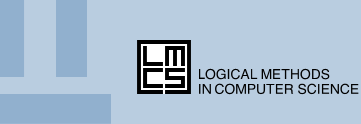 |
 |
Paul-André Melliès ; Noam Zeilberger - The categorical contours of the Chomsky-Schützenberger representation theorem
lmcs:13654 - Logical Methods in Computer Science, May 16, 2025, Volume 21, Issue 2 - https://doi.org/10.46298/lmcs-21(2:12)2025 We develop fibrational perspectives on context-free grammars and on nondeterministic finite-state automata over categories and operads. A generalized CFG is a functor from a free colored operad (aka multicategory) generated by a pointed finite species into an arbitrary base operad: this encompasses classical CFGs by taking the base to be a certain operad constructed from a free monoid, as an instance of a more general construction of an \emph{operad of spliced arrows} $\mathcal{W}\,\mathcal{C}$ for any category $\mathcal{C}$. A generalized NFA is a functor from an arbitrary bipointed category or pointed operad satisfying the unique lifting of factorizations and finite fiber properties: this encompasses classical word automata and tree automata without $\epsilon$-transitions, but also automata over non-free categories and operads. We show that generalized context-free and regular languages satisfy suitable generalizations of many of the usual closure properties, and in particular we give a simple conceptual proof that context-free languages are closed under intersection with regular languages.
Finally, we observe that the splicing functor $\mathcal{W} : Cat \to Oper$ admits a left adjoint $\mathcal{C}: Oper \to Cat$, which we call the \emph{contour category} construction since the arrows of $\mathcal{C}\,\mathcal{O}$ have a geometric interpretation as oriented contours of operations of $\mathcal{O}$. A direct consequence of the contour / splicing adjunction is that every pointed finite species induces a universal CFG generating a language of \emph{tree contour words.} This leads us to a generalization of the Chomsky-Schützenberger Representation Theorem, establishing that a subset of a homset $L \subseteq \mathcal{C}(A,B)$ is a CFL of arrows if and only if it is a functorial image of the intersection of a $\mathcal{C}$-chromatic tree contour language with a regular language.
- Source : OpenAIRE Graph
- a cartographic quest between lambda-calculus, logic, and combinatorics; Funder: French National Research Agency (ANR); Code: ANR-21-CE48-0017
- Reasoning with Circular proofs for Programming; Funder: French National Research Agency (ANR); Code: ANR-21-CE48-0019
- Coq-based Rewriting: towards Executable Applied Category Theory; Funder: French National Research Agency (ANR); Code: ANR-22-CE48-0015